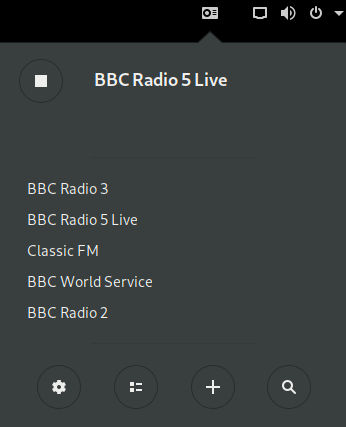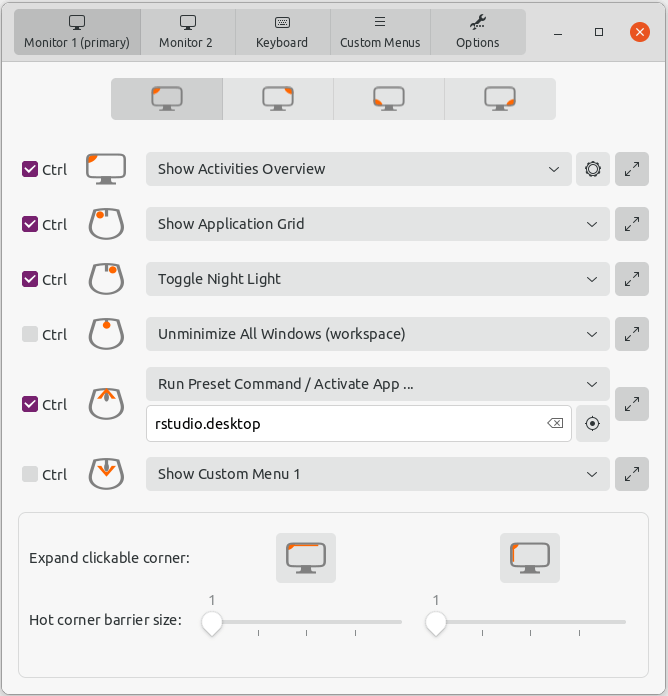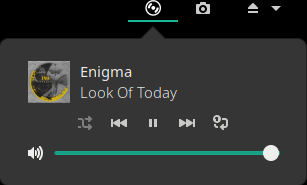5. Internet Radio
 This is a rather snazzy shell extension that lets you listen to internet radio streams with the minimum of fuss and bother. It’s definitely our favorite multimedia extension by a country mile.
This is a rather snazzy shell extension that lets you listen to internet radio streams with the minimum of fuss and bother. It’s definitely our favorite multimedia extension by a country mile.
The configure button lets you turn on title notifications, title notifications in the panel, play/stop media keys, volume adjustment slider in the menu, and enable it as a search provider. The playlist button lets you define which streams to show, edit stream information, delete streams, and play streams. Add new streams by clicking the + button. The latter option lets you show radio stations as search results in the GNOME overview.
The built-in radio directory radio-browser is a real time-saver. Fab! If you like listening to radio on your computer, you’ll love this extension!
Website: github.com/hslbck/gnome-shell-extension-radio
6. Window-List

Like Dash to Dock, this extension restores another one of the traditional metaphors to your GNOME experience. Window List displays a window list at the bottom of the screen. It’s a simple way of making your GNOME desktop feel more comfortable if you’re coming from a Windows background.
The extension lets you configure the window grouping. Choose between new grouping windows, group windows when space is limited, or always group windows. There’s also the option to show the window list on all monitors, or a single monitor.
This extension is part of Classic Mode and is officially supported by GNOME.
Website: gitlab.gnome.org/GNOME/gnome-shell-extensions
7. Custom Hot Corners – Extended

This extension offers a huge collection of actions that allows you navigate and control the GNOME Shell environment and windows and launch applications and scripts not only through the corners and edges of your monitors, but also using the custom keyboard shortcuts.
Website: github.com/G-dH/custom-hot-corners-extended
8. Mpris Indicator Button
 This is one extension any music fan will want to install on their GNOME desktop.
This is one extension any music fan will want to install on their GNOME desktop.
It’s a very useful, well designed, and full featured MPRIS indicator. Sweet and simple!
The Media Player Remote Interfacing Specification is a standard D-Bus interface which aims to provide a common programmatic API for controlling media players.
Website: github.com/JasonLG1979/gnome-shell-extension-mpris-indicator-button
Next page: Page 3 – Vitals, Screenshot Tool, Net speed Simplified, Clipboard Indicator
Pages in this article:
Page 1 – Dash to Dock, Arc Menu, Section Todo List, OpenWeather
Page 2 – Internet Radio, Window-List, Custom Home Corners, Mpris Indicator Button
Page 3 – Vitals, Screenshot Tool, Net speed Simplified, Clipboard Indicator
Page 4 – Stocks-Extension, Timezone, Desktop Icons NG, GSConnect
Page 5 – Recent Items, you2ber, ddterm, Auto Move Windows
Page 6 – Places Status Indicator, Time ++, Just Perfection, Top Panel Workspace Scroll
Page 7 – Impatience, System monitor, Frippery Panel Favorites, Removable Drive Menu
Page 8 – No overview at start-up, Extension List, Caffeine, BlurMyShell
Page 9 – Burn My Windows, Coverflow Alt-Tab, Material Shell, Colosseum
 Read our complete collection of recommended free and open source software. Our curated compilation covers all categories of software. Read our complete collection of recommended free and open source software. Our curated compilation covers all categories of software. Spotted a useful open source Linux program not covered on our site? Please let us know by completing this form. The software collection forms part of our series of informative articles for Linux enthusiasts. There are hundreds of in-depth reviews, open source alternatives to proprietary software from large corporations like Google, Microsoft, Apple, Adobe, IBM, Cisco, Oracle, and Autodesk. There are also fun things to try, hardware, free programming books and tutorials, and much more. |

There’s quite a few here which are undiscovered gems.
Burn My Windows should be much higher. It really adds sparkle to the drab default GNOME desktop
drab?
With those extensions, Gnome will gain as much flexibility as KDE. Is this the design intention?
GNOME extensions add additional functionality and are very useful particularly as the focus on GNOME is to make the desktop as easy to use as possible and so some features the community liked were removed
My issue with extensions is that so many are abandoned. This isn’t because the project code is too hard to maintain to remain compatible with newer releases of GNOME. I speculate it’s because many of the extensions’ authors are fairly new to programming. Writing an extension is a good introduction to learning how to program. Its just these developers move on to more substantial projects.
I would love to see a group of developers take on abandoned extensions that were really popular. Too many times all the source code is effectively junked and someone new comes along, reinvents the wheel but the outcome is worse than the original.
Some people contend the simplification of GNOME was done for a target audience that doesn’t actually exist. My opinion was that many of the changes were motivated because the code base was in bad shape. It’s much easier to maintain and improve a software project if you reduce its complexity. Removing features is a start.
Burn My Windows is a super cool extension.
Thanks for not spamming this page with so many ads my vm crashes. Decent content, straight forward info. It’s appreciated.